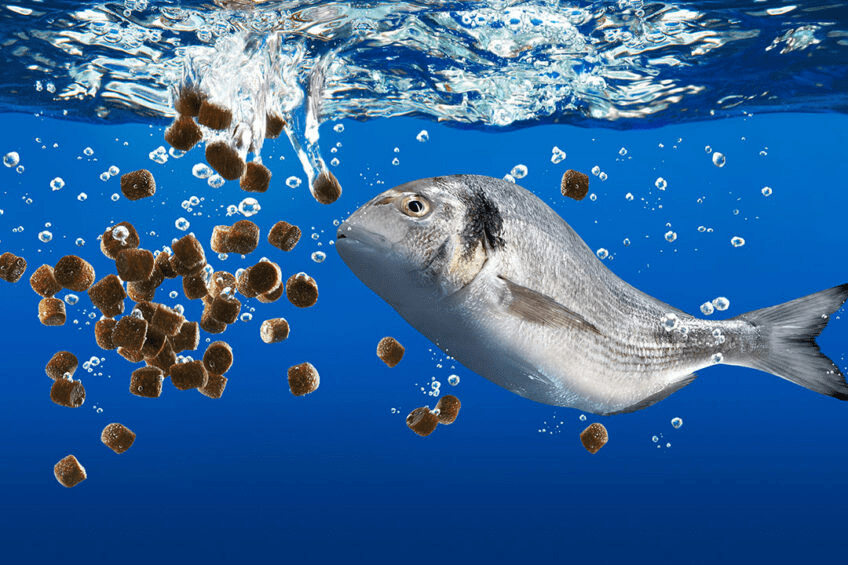Feed formulation is essentially applied nutrition including fish feed formulation. A number of terms and expressions are introduced that will be put to practical use as information is presented on the nature and qualities of various feedstuffs and the information presented on the nutrient requirements of fish.
Precise understanding of these terms is essential to their correct application. One must recognize that some of these terms have a built-in error that cannot be escaped.
This does not eliminate their usefulness in feed formulation. However, one must appreciate the fact that some are useful approximations of the values and not true values.
The terms that one needs to understand to formulate practical fish diets are: crude protein level; energy level, either expressed as metabolizable energy (ME) or as digestible energy (DE); specific amino acid levels; crude fibre level; and ash level.
Since most complete practical fish diets are supplemented with a vitamin premix at levels in excess of the dietary requirement, this category of nutrients will be ignored temporarily.
The potential problems occur when one fails to recognize that all of the above mentioned terms, except ME and DE, represent the quantity or level of a nutrient in the feed as determined by chemical tests on a specific sample of a feedstuff.
These chemical tests generally correlate well enough with biological methods of feed evaluation (growth studies, tissue, levels) to be very useful to feed formulators, but they are still chemical tests that are subject to experimental error during nutrient level determination.
For example, the proximate composition of fish meals changes during the spawning season. Generally, the lipid levels increase before spawning and decrease after spawning.
This will alter the percent of protein, ash, and carbohydrates in fish meal as the seasons change. Similarly, many plant feedstuffs vary in proximate composition with their stage of maturity at harvest, location grown, and other environmental conditions, such as the weather.
Tabled values represent an average value that is usually close enough to the actual value to allow accurate feed formulation. However, one must be aware that assumptions are being made in order to recognize the potential sources of error that may exist.
Metabolizable, energy and digestible energy values are obtained biologically and, thus, should accurately represent the true energy value of feedstuffs to fish.
However, ME values may be obtained in different ways (faeces collection methods) and thus may be subject to experimental error.
It has recently been reported that the digestibility of feed by rainbow trout was lower at 7°C than at 11°C or 15°C. At 11°C and 15°C body size (18.6 g, 207.1 g or 585.7 g) did not affect feed digestibility.
The digestibility of carbohydrate and energy was slightly reduced by meal size in rainbow trout fed at 1.6 percent body weight. Protein and lipid digestibility was not reduced by meal size.
Obvious differences exist between fish species in nutrient digestibility, especially in the carbohydrate fraction of feed.
Herbivorous and, to a lesser extent, omnivorous fish have longer digestive tracts than do carnivorous fish and are able to obtain more digestible energy from carbohydrates. An awareness of these facts will prevent misuse of ME and DE values.
Each feedstuff in any diet formulation should be present for a specific reason; i.e., it is a good energy source, it is rich in a limiting amino acid, etc. In addition, each feedstuff in a particular diet formulation should be the least costly ingredient available for its particular function in the diet.
This leads to another assumption in feed formulation; that is, any nutrient in a particular feedstuff, such as an amino acid, is just as valuable as the same nutrient in any other feedstuff.
This allows feed formulators to interchange one feedstuff with another as cost and availability change. Thus, it is assumed that there is no “ideal formulation”, but rather an almost infinite number of possible feed formulations that met the nutritional needs of the fish equally well.
While this assumption may not be entirely valid and some nutritional judgment must be employed in any feed formulation, it does seem to be valid in most cases.
As with the previously mentioned assumption, an awareness of the potential pitfalls involved is necessary for the fish feed formulation so that allowances can be made in diet formulation and problems can be anticipated and avoided.
Balancing Crude Protein Level
In most animal diets, protein is the most expensive portion and is usually the first nutrient that is computed in diet formulation.
The energy level of the diet is then adjusted to the desired level by addition of high energy supplements) which are less expensive than protein supplements.

The square method is an easy way to determine the proper dietary proportions of high and low protein feedstuffs to add to a feed to meet the dietary requirement of the animal to be fed.
Read Also: Classification of Animal Feedstuffs
For example, suppose rice bran and soybean meal were available as feedstuffs to prepare a diet for carp that was 25 percent crude protein.
A square is constructed and the two feedstuffs are put on the two left corners along with the protein content of each. The desired protein level of the feed is placed in the middle of the square.
Next, the protein level of the feed is subtracted from that of the feedstuffs, placing the answer in the opposite corner from the feedstuff. Ignore positive or negative signs.
To make the 27 percent crude protein carp feed, we must mix 17/35.8 of rice bran with 18.8/35.8 soybean meal.
So to make 100 kg of this feed we must mix 47.5 kg of rich bran with 52.5 kg of soybean meal.
If more than two feedstuffs are used in a feed, they may be grouped into basal feeds (CP < 20 percent) and protein supplements (CP > 20 percent), averaged within each group, and plugged into the square method.
For example, suppose shrimp meal and corn were also available for the carp feed mentioned above.
The crude protein levels of the shrimp meal (52.7 percent) and of corn (10.2 percent) are averaged with soybean meal and rice bran, respectively.
Thus, to make 100 kg of this feed one would mix the following:
| Rice bran | 27.265 kg |
| Corn | 27.265 kg |
| Soybean meal | 22.735 kg |
| Shrimp meal | 22.735 kg |
The square method is helpful to novice feed formulators because it can get them started in diet formulation without the need to resort to trial and error.
The square method can also be used to calculate the proportion of feeds tuffs to mix together to achieve a desired dietary energy level as well as a crude protein level.
If one wanted to make a feed containing 2 500 kcal ME/kg using wheat middlings (1663 kcal ME/kg) and anchovy fish meal (4 371 kcal, ME/kg) a square could be constructed as follows:
The square method cannot be used to simultaneously solve for both crude protein level and ME level.
Steps in Fish Feed Formulation
The first step in diet formulation is balancing the crude protein and energy levels.
This can be accomplished by trial and error, by the square method for either crude protein level or energy level and then adjusting, or by solving simultaneous equations.
At first, it is helpful to use at least three feeds tuffs during the initial balancing of protein and energy levels: one high in protein and high in ME, one low or intermediate in protein and high in ME, and one low or intermediate in both protein and ME.
Once practice makes one more proficient at diet formulation any number of feedstuffs can be used. One must remember to reserve room in the formulation for any feed additive, such as a vitamin or mineral pre-mix.
The second step in diet formulation is to check the levels of indispensable amino acids in the formulation to be sure the dietary levels meet the requirements of the animal to be fed.
The requirements of fish for indispensable amino acids is expressed as the dietary level (as a percent of the diet) or as a percent of the dietary protein level. To convert an amino acid level from the percent of diet to percent of protein, divide the dietary level of each amino acid by the dietary protein level.
It might be of interest to calculate the dietary levels of all of the indispensable amino acids, but it is not practical to do it all of the time.
Read Also: Ornamental Fishes and Aquaria Design
If the levels of arginine, lysine, methionine, and tryptophan meet the dietary requirements of the fish to be fed, the levels of the other six indispensable amino acids will most likely be above required levels.
When using unconventional protein supplements, the levels of all ten indispensable amino acids should be checked.
If the diet formulation is low in any amino acid, a feedstuff that contains high levels of that amino acid must be added to the diet at the expense of another ingredient.
Once the amino acid requirements are met, the dietary protein and energy levels must be rechecked to, see if any substitution of ingredients has imbalanced the formulation.
A diet mixing sheet should be constructed to standardize diet formulation. The amino acids listed are for illustration purposes only and may be changed to suit different circumstances.
In practical feed formulation, pellet quality and acceptability must be considered in addition to nutrient levels and cost. These considerations will vary from species to species and with the type of pellet.






